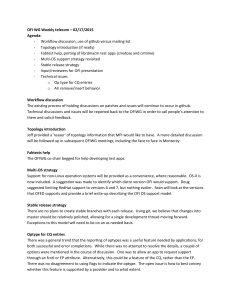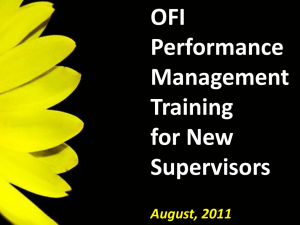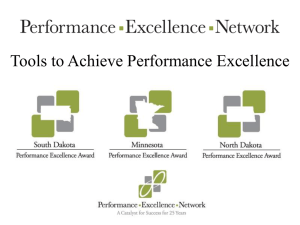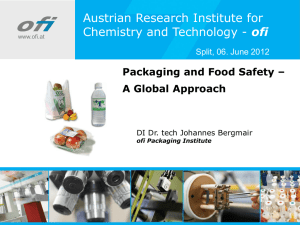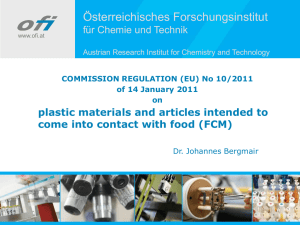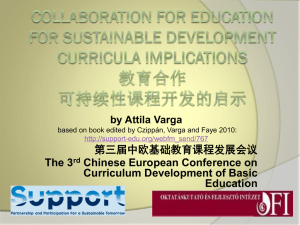Renewables vs. Biodegradability – New Packaging Materials
advertisement
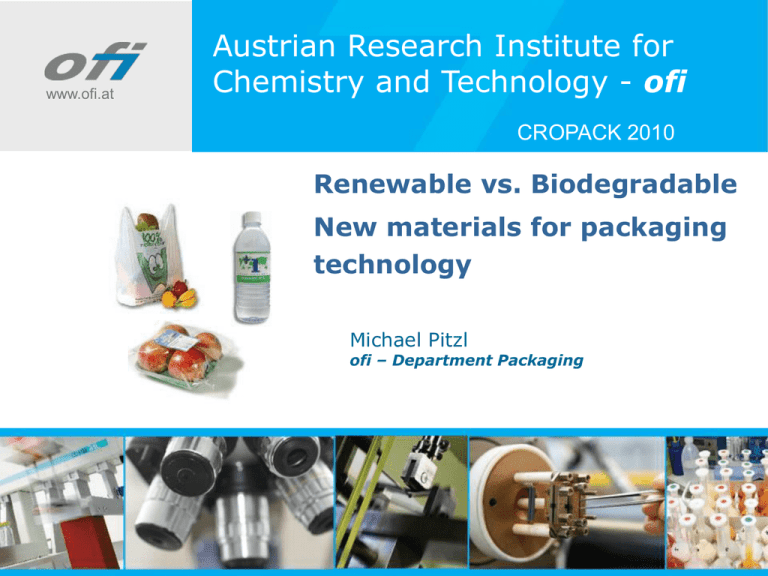
Austrian Research Institute for Codex-UK ´Gebrauchsgegenstände´ Chemistry Technology - ofi bearbeiten www.ofi.atTitelformatand 3. Juni 2008 / BMGFJ CROPACK 2010 Renewable vs. Biodegradable New materials for packaging technology Michael Pitzl ofi – Department Packaging An inconvient truth? www.ofi.at 2 Source: www.youtube.com 2010-02-18 Solution – Bioplastics? www.ofi.at Recent headlines: Coca-Cola Co announced the selective global roll-out of its new PET bottle made from up to 30 per cent plant materials such as sugar and molasses. Bioserie iPhone® Case is really green! Advertising slogan: Packaging without the guilt? Bioplastics Source: www.plasticsnews.com 2010-02-17 www.ubergizmo.com 2010-02-22 3 New materials? www.ofi.at Before 1940 approx. 80 % of commercially available biodegradable plastic and its monomers were discovered and described 1938 Polyethylen In the 70s: • Oil crises (1973) • Set point for further development In the 80s: • Oil crises (1980) – pilot plants for bioplastics • Oxodegrable products – inhibited the further development? Source: NARAYAN R. et al. 1994 www.n24.de 2010-02-17 4 Definition of Bioplastic www.ofi.at Up to now not fixed (CEN/TC 249/WG 17 planed release 2010) According to European Bioplastics: Plastic based on renewable resources Biodegradable polymers which meet all criteria of scientifically recognized norms for biodegradability and compostability of plastics and plastic products (EU: EN 13432 / EN 14995, US: ASTM D-6400, ISO 17088). NOT oxodegradable! 5 Source: www.european-bioplastics.org 2010-02-17 Definition of Bioplastic www.ofi.at Biodegradable material based on renewable ressources Biodegradable material based on petrochemical ressources Non degradable material based on renewable ressources Non degradable material based on petrochemical ressources (OXODEG.) 6 www.ofi.at Development of the market Capacity 2009 400.000 t worldwide Small market, but high growth rates up to 10 % 7 Source: www.european-bioplastics.org 2010-02-17 State of development www.ofi.at Research > Development > Pilot Plant > Commercialization > World-scale Plant > Industrial production 8 Source: bioplastics Magazine 03/2007 Biodegradable materials www.ofi.at In general 4 materials commercially available • Starch-based polymers • Polylactic acid • Polyhydroxyalkanoates • Cellulose derivates Chitosan? Polymer blends and composites Source: www.basf.com 2008-09-12 YU L. et al. 2006 9 Starch-based polymers Mater-Bi® www.ofi.at Maize and/or potatoe starch in blend with polycaprolactones and other biodegradable esters Europeas most common bioplastic 10 Source: www.novamont.com 2009-12-01 Starch-based polymers Others www.ofi.at Plantic® Starch from maize and hydroxypropyl, Plantic Technologies (AUS) Solanyl® Starch from potatoes, Rodenburg Biopolymers (NL) Bioplast® Starch blend, Biotec (DE) Biopar® Starch from potatoes and blends, Biop AG (D) Similar to PE (converting) Limited applications! 11 Source: www.plantic.com.au 2009-04-01 Polylactic acid www.ofi.at Main producer: NatureWorks (US) Other Producers: Hycail (FI), Toyota (J) and Uhde Inventa (D) Glucose from maize or lactose from whey 12 Source: LIM L.-T. et al. 2008 Polylactic acid blends www.ofi.at Ecovio® 45 % PLA + Ecoflex®, BASF (D) Ecovio® L-Foam 75 % PLA + Ecoflex®, BASF (D) Bio-Flex® PLA + Copolyester, FKuR (D) Similar to PET and/or PS (converting) Sensitive to temperature! Source: www.basf.com 2008-09-12 YU L. et al. 2006 13 Polyhydroxyalkanoates www.ofi.at Mirel™ Metabolix (US) Biomer™ Biomer (D) PHB, PHV, PHBV, ... Fermentation of starch, rape, plant residues, etc. Only Injection Moulding! 14 Source: www.metabolix.com 2008-09-12 Cellulose derivates www.ofi.at NatureFlex™ Innovia (UK) Barrier coatings! 15 Source: www.innoviafilms.com 2008-09-12 Comparision www.ofi.at Thermal properties: Melting temperature Biopolymers comparable with conventional plastics 16 Source: WEBER C. J. 2000 Comparision www.ofi.at Oxygen transmission rate Biopolymers in the midfield 17 Source: WEBER C. J. 2000 Comparision www.ofi.at Water vapour transmission rate Biopolymers in the midfield 18 Source: WEBER C. J. 2000 Comparision www.ofi.at Transmission of UV-light 19 www.ofi.at Food safety packaging material Nearly all starting substances are listed Migration values are below legal limits No significant difference in microbial growth on packaging material No desintegration during shelf life Migrants from PLA are safe 20 End of life www.ofi.at End of life Composting? 21 Source: WEBER C. J. 2000 End of life www.ofi.at End of life Compsoting? 22 Source: ENDRES H.-J. 2009 THANK YOU! www.ofi.at Michael Pitzl E-Mail: michael.pitzl@ofi.at Austrian Research Institute for Chemistry and Technology - ofi Brehmstraße 14a A-1110 Wien +43-(0)1-798 16 01 - 597 +43-(0)1-798 16 01 - 480 23
